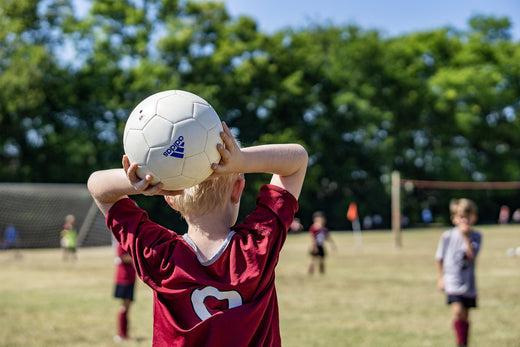A football throw in is the restarting of the playing action once the football ball crosses the boundaries of the playing field.
Since throwing in is one of the basic aspects of football, football throw in drills are a great way to help football players perfect the technique.
Besides, they can also help the players to learn the technique of initiating an attacking move on the opposition from a throw in.
Football Throw In Rules
Before the drills, a football coach needs to explain the rules associated with a throw in to the players. Without knowing the rules, the thrower might make an illegal throw and lose possession.
A throw in is awarded to the opponent team of the player who has last touched the ball. The thrower should stand facing the field and have both feet placed on or outside the touchline.
The ball should be thrown in by both hands with an overhead movement from the point from which it left the playing field. The opponents need to stand at least 2 yards away from the sideline at the throwing point.
Note, a player cannot score a goal from a direct long throw. Also, the goalkeeper from the same team cannot receive the ball from a throw in directly with their hands.
Once the throw is complete, the thrower cannot touch the ball unless it has been touched by another player. If this rule is violated, an indirect free kick is awarded.
Football Throw in Drills
Throw in drills can be practiced as an additional part of any u8 drill for a youth football team.
To start with, choose two players from the same team. One of them being the thrower and the other the receiver. The thrower stands at the sideline and makes the throw to the receiver.
The receiver should practice receiving the ball directly from the throw before it touches the ground. A practical coaching tip is to practice both long and high throw ins during a training session.
One important coaching point for the thrower is to make sure that the throw is not directed at chest or head height. Apart from the right height, the throw should be aimed correctly, and not be too forceful.
An overly forceful or misdirected throw will put additional pressure on the receiver, especially when the opposition defenders are around.
In the next stage, a defender and an additional teammate can be introduced in the drill. The thrower needs to disguise the throw action to deceive the defender and make him run to the wrong player. The actual throw can then be directed to the right teammate.
In more advanced throw-in football drills, you can create a 3 v 2 situation. For this, you need to bring in one more defender into the situation.
Once the first teammate receives the ball, they can pass it to the other teammate before the defender intercepts.
Another option is to make a long pass to the third teammate who has moved into an attacking position. This allows the teammate to dribble the ball and move toward the opposition’s goal.
Final Thoughts
Football throw in drills are an important aspect of football training for all age groups. Taking advantage of a throw in is one of the many fundamental football skills that players should master in a football session.
As a coach, you need to make sure that your players master the throw in technique. In addition, they should be able to use it as a decisive move to increase pressure on the opposition in a football game.
The backstop, net, and football rebounder ensures that the ball stays in play and prevents it from going into nearby woods or roadways. The rebounders come in a number of sizes based on your young players age. Click here to learn more!


